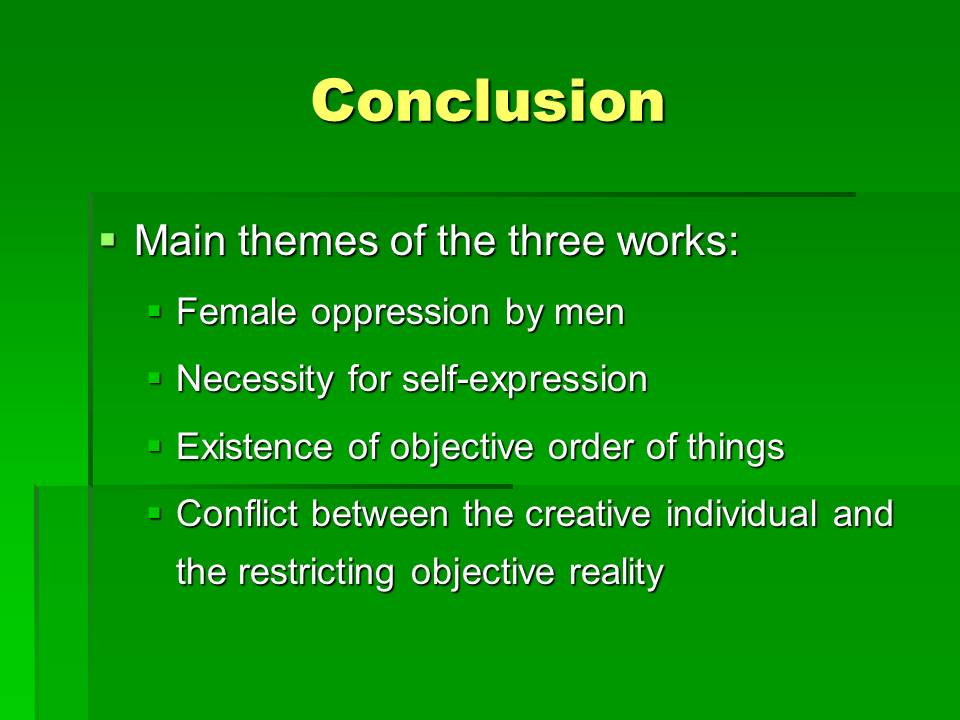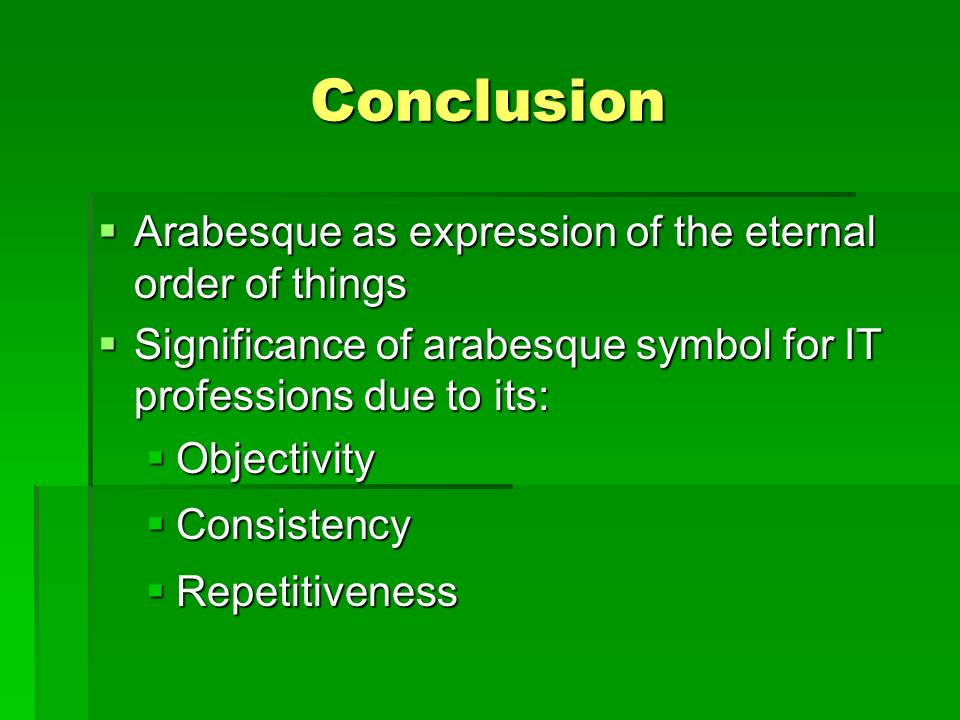Introduction
Literature
- Charlotte Perkins Gilman (1860-1935)
- “The Yellow Wallpaper”, 1892
- A short story considered a breakthrough in feministic literature
“The Yellow Wallpaper”, the work of literature under discussion, was created by a prominent American writer Charlotte Perkins Gilman in 1892. This short story was considered a breakthrough in feministic literature since it clearly highlighted the position of women in nineteenth-century society.
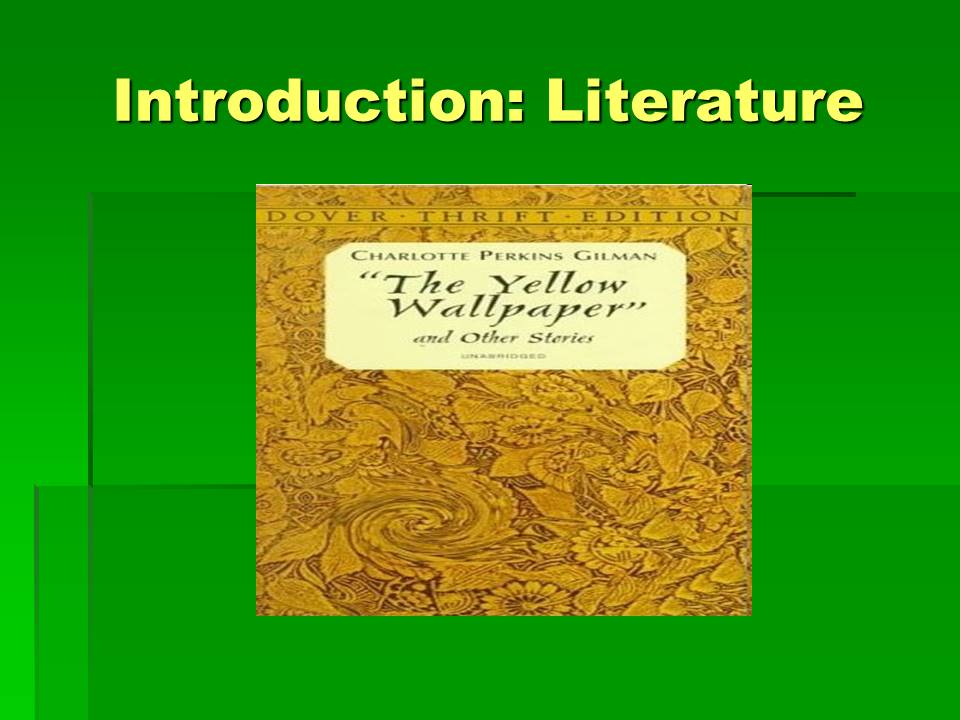
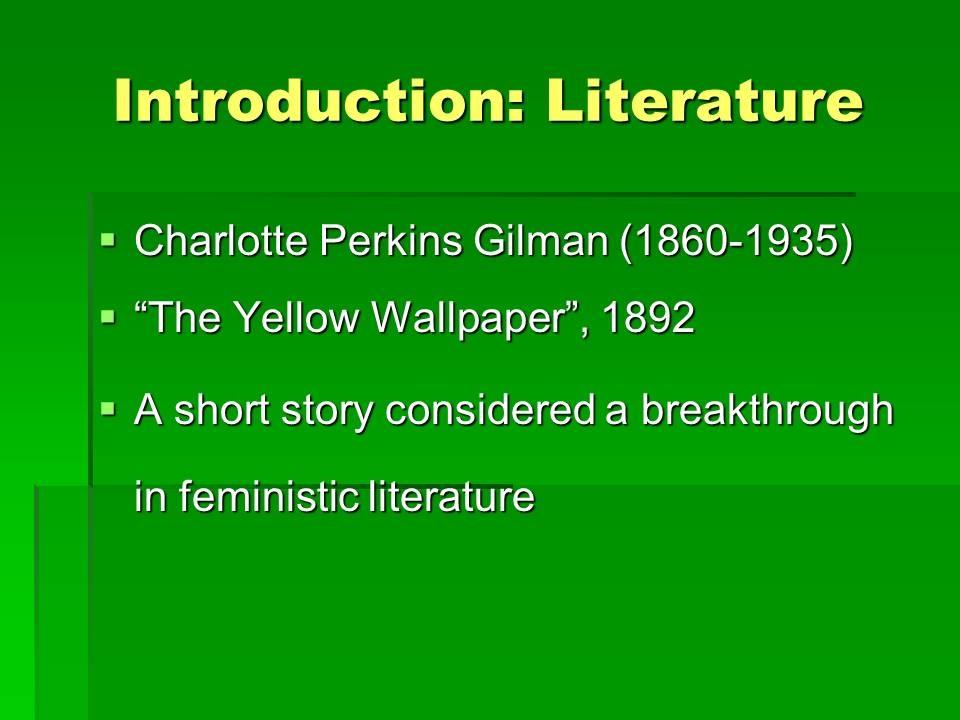
Painting
- Gustav Klimt (1862-1918)
- Portrait of Adele Bloch-Bauer I, 1907
- Completed within three years, this 138×138 cm canvas became one of the most expensive paintings ever sold
At the beginning of the twentieth century, the Austrian Symbolist painter Gustav Klimt completed a series of portraits, among which Portrait of Adele Bloch-Bauer I is singled out by its complex and posh ornamentation. Bought by New York Neue Galerie in 2006, this painting is considered one of the most expensive works of art ever sold.
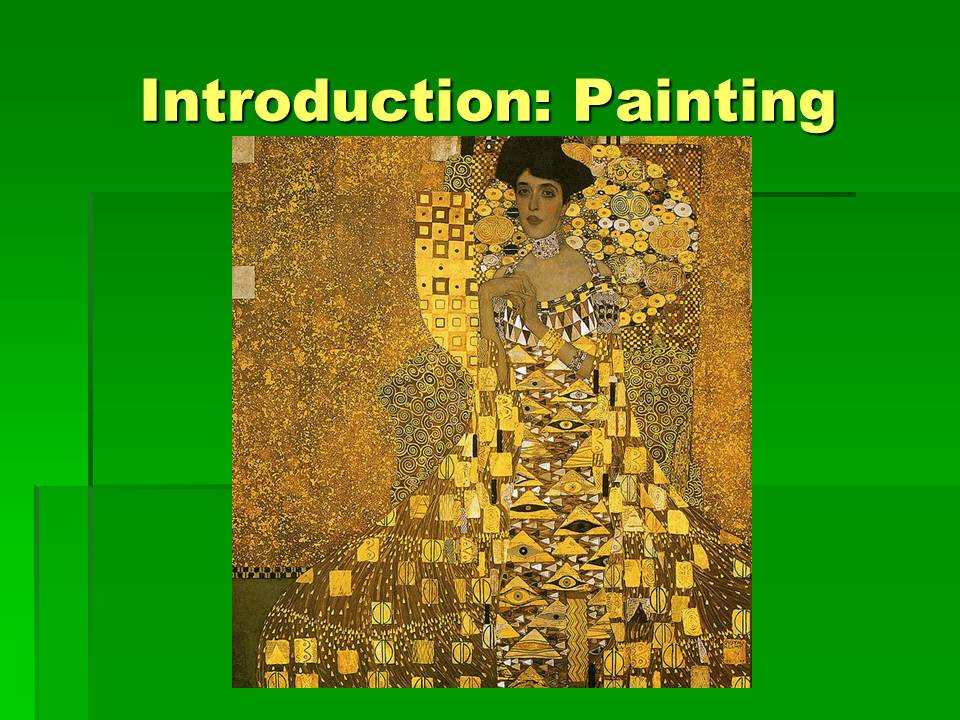
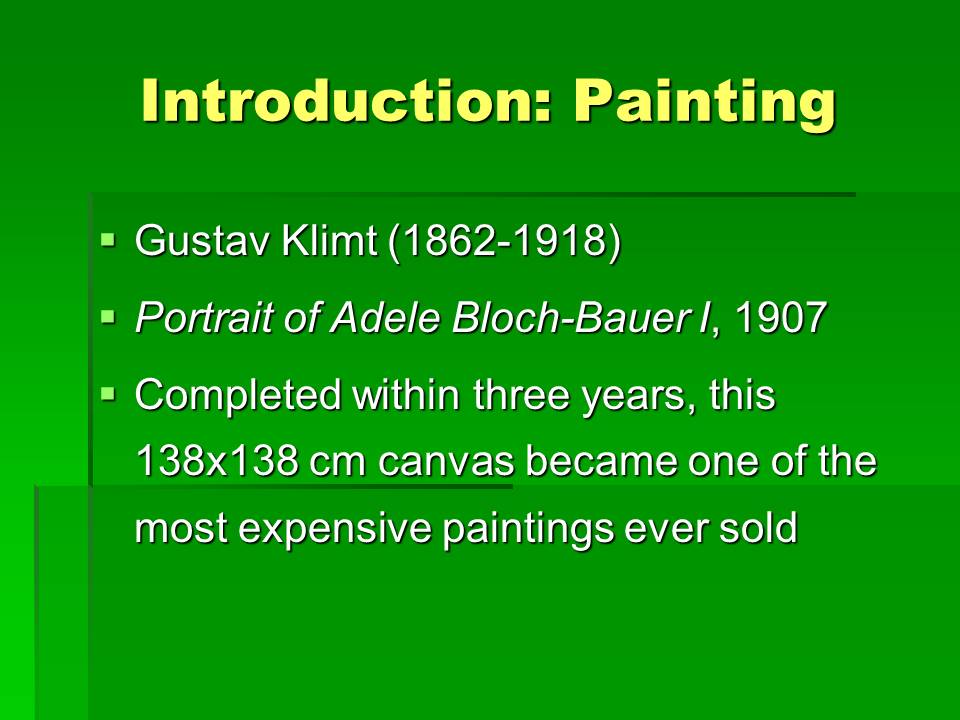
Music
- Claude Debussy (1862-1918);
- Two Arabesques (1888-1891);
- The two short works for piano were composed by Debussy in his late twenties and reflect the peculiarities of his developing musical style.
One of the brightest representatives of French Impressionism in music, Claude Debussy debuted as piano composer in the late 1880s. The Two Arabesques were his first published works for piano and already reflect the peculiarities of the composer’s developing musical style.
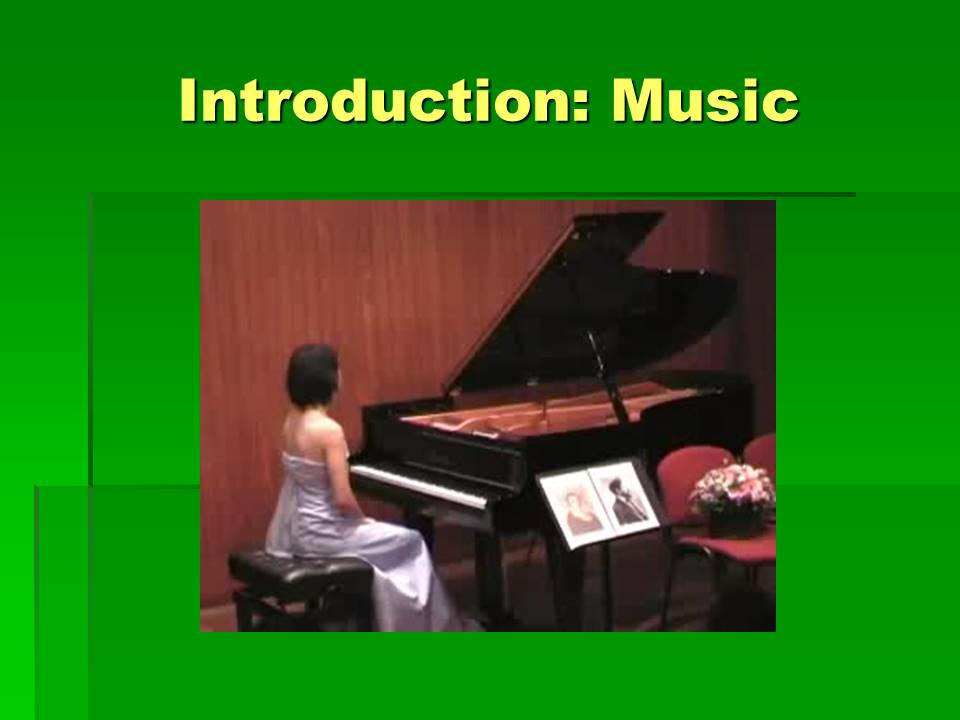
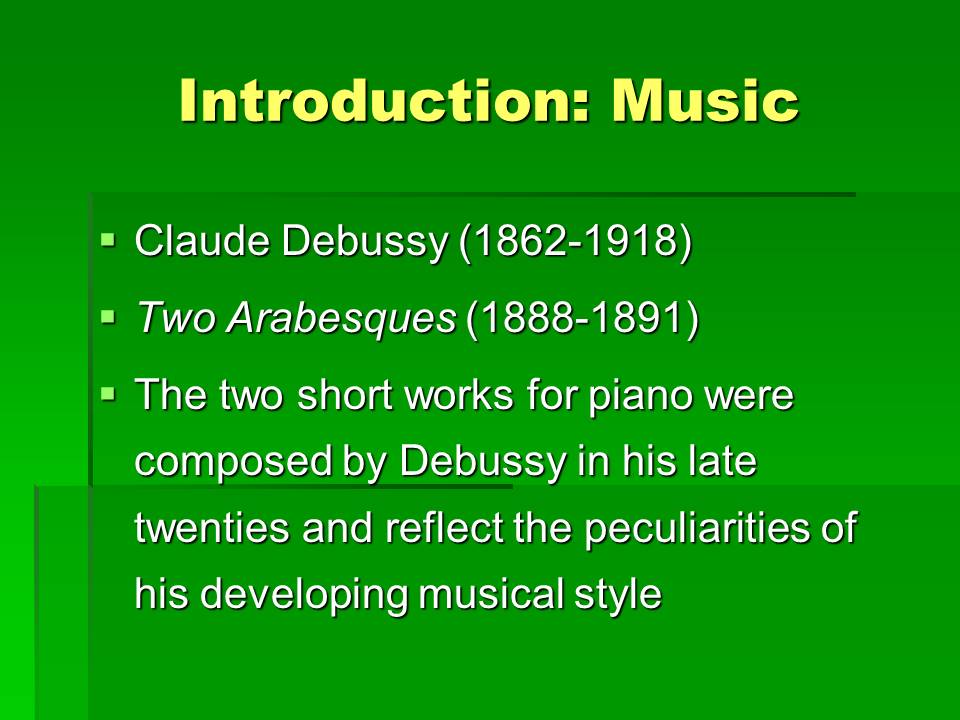
Thesis Statement
The three works under discussion are united by the common idea of arabesque as a pattern possessing the qualities of consistency, repetition, and infinity. These qualities appear crucial for the profession of network designer due to their orderly and systematic character.
Despite the variety between the art disciplines, the short story, the painting, and the music piece contain a prevailing idea that allows connecting them thematically. The three works under discussion are united by the common idea of arabesque as a pattern possessing the qualities of consistency, repetition, and infinity. These qualities appear crucial for the profession of network designer due to their orderly and systematic character.
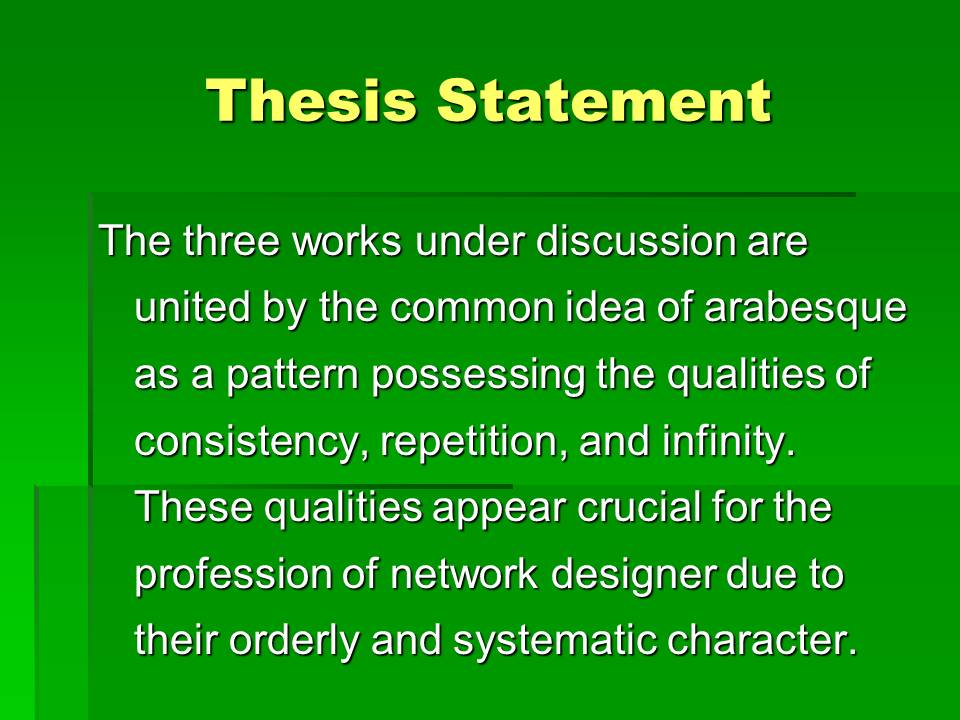
Objective Analysis
Literature
Form
- Short story
- Secret journal / diary
The formal genre of The Yellow Wallpaper is a short story. Written in the first person, it narrates the events in form of a secret diary or journal recording both the outside developments and the inner intimate concerns of the female narrator.
Subject Matter
- The physical and mental condition of a woman suffering a postnatal depression
- The oppression of the woman’s individual desires by the tyrannical husband
- The gradual emancipation of the woman from her physical and mental imprisonment
The subject matter of The Yellow Wallpaper is the gradual change in the physical and mental condition of a woman who suffers a postnatal depression and is locked up in a room away from her child. Any individual desires and impulses of the woman are controlled by her tyrannical husband whose authority is based on his medical background. The woman manages to escape this totalitarian dictatorship by escaping into the imaginary world behind the yellow wallpaper in her room. Associating herself with the woman who hides behind the arabesque pattern of the wallpaper, the narrator breaks through the bars of the pattern and thus triumphs over her husband’s total control.
Painting
- Genre & Media
- Portrait
- Oil, silver, and gold on canvas
- Subject Matter
- Adele Bloch-Bauer, the wife of Klimt’s wealthy sponsor
The genre of the painting is a portrait which Klimt chose to perform through the media of oil, silver, and gold on canvas in order to emphasize the splendor and grandeur of the model. The subject matter of Adele Bloch-Bauer I is the depiction of the wife of Klimt’s wealthy sponsor, a sugar industrialist interested in the arts.
Artist’s techniques in terms of media and style
- Luxurious effects achieved by use of precious metals
- Mosaic collage reminding of the Byzantine techniques
- Repetitive motif of arabesque referring to Oriental origins
- Busy pattern as if engulfing the woman
The painting strikes by its luxury and splendor achieved via usage of rare precious materials. Gold and silver shine in a fanciful mosaic collage that remind of the Byzantine artistic techniques employed for depicting lives of saints and emperors. Embedded in the yellow-shaded composition is the motif of arabesque which has its origins in the Oriental art and produces a hypnotizing effect by its florid repetitiveness. Against such rich decorative background, the figure of the woman seems to be lost and as if imprisoned in the golden splendor surrounding her.
Music
- Genre & media
- Arabesque
- Piano
- Subject matter
- Perpetuum mobile of musical sounds resembling the eternal flow of intricate patterns of an Oriental arabesque
Labeled as Two Arabesques, the two piano miniatures by Claude Debussy are characterized by a continuous flow of repeating sounds and motives. This constant repetitive movement reminds of the eternal flow in which the intricate patterns of an Oriental arabesque involve in works of Islamic art.
Composer’s techniques in terms of media and style
- Continuous repetition of sounds and motives produces the impression of:
- Eternity
- Infiniteness
- Spontaneity
- Lack of systematic character in the musical sounds along with their persistence as if force the music on to the listener
- The rich embellishment of the musical material does not promote clarity
In his music pieces Debussy imitates the repetitive nature of arabesque in visual arts by continuous repetition of sounds and motives. This never-ending flow produces the impression of eternity, infiniteness, and spontaneity. Lack of systematic character in the musical sounds along with their persistence as if force the music on to the listener who gets lost in the intricate repeating patterns. The rich embellishment of the musical material does not promote clarity either and only confuses the listener further.

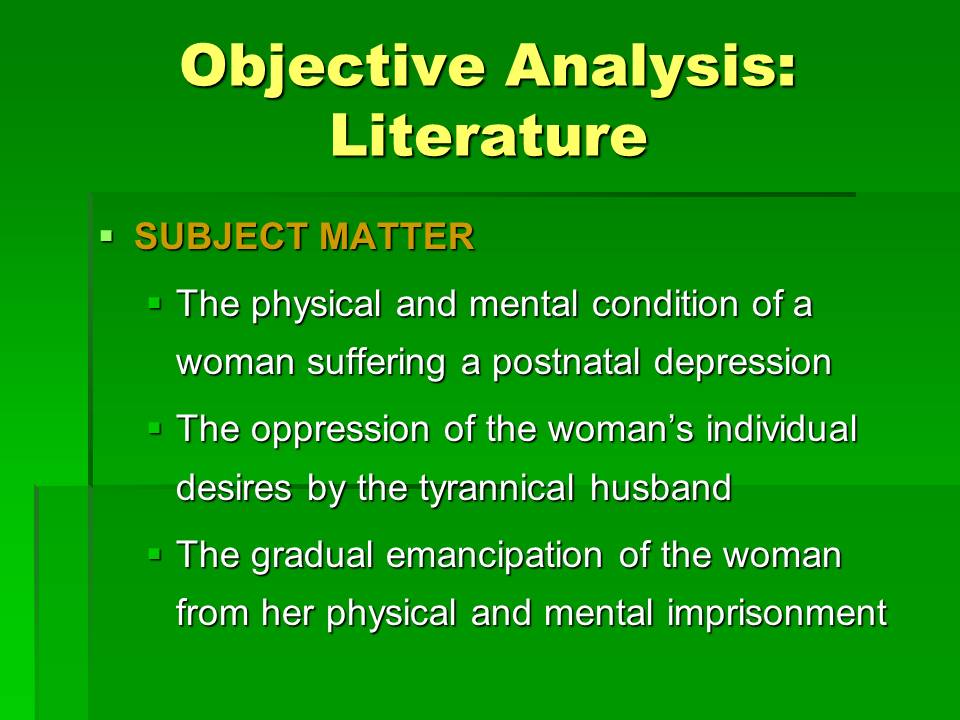
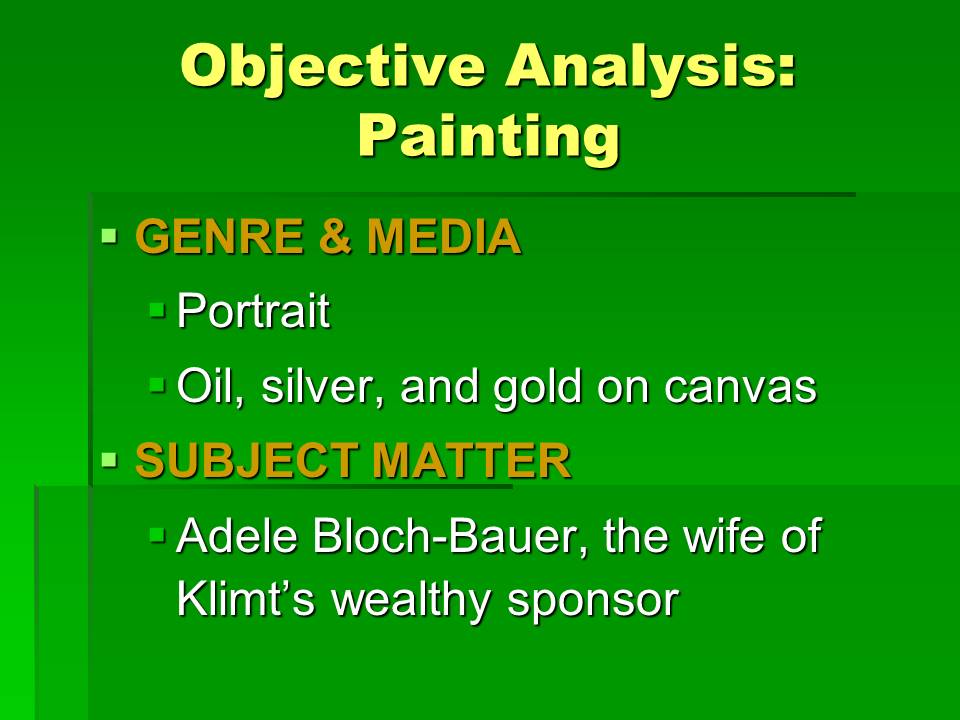



Subjective Analysis
Literature
- Interpretation of meaning
- Imprisonment of woman in the web of social restrictions
- Mood
- Mysteriousness of the setting and compassion towards the oppressed main character
In The Yellow Wallpaper, Charlotte Perkins Gilman strives to deliver the message of imprisonment of the nineteenth-century women in the web of social restrictions. Every aspect of female life, from education and work to simple communication with her own children, is under total control of the male society which does not take into account the individual desires and needs of women.
Creating an air of mystery over the nursery with yellow wallpaper where the woman is confined, Perkins brings along a feeling of compassion towards the main character. The woman is oppressed in a world hostile to her and thus tries to escape by integrating herself into that world.
Themes and overarching ideas & concepts
- Oppression of married women
- Necessity for individual expression
- Arabesque pattern as a web engrossing the female personality
Gilman unfolds a whole range of themes and ideas in her short story. The key theme appears to be the oppression of married women in the nineteenth century by their husbands who seem to have concluded an agreement with social institutions (inter alia, medicine) to keep their wives as limited in their activities as possible. The woman’s tragedy lies in the impossibility for her personal self-expression: separated from her child, she is denied any activities and even having ideas is prohibited to her by her husband (Gilman 6). In this context, the everlasting arabesque pattern of the yellow wallpaper is viewed as a suffocating web that engrosses and limits the female creative personality.
Understanding the meaning, mood, and theme of the story was reached through paying attention to the vocabulary of the text and the repetitive ideas employed by Gilman.
Painting
- Interpretation of meaning
- Imprisonment of the woman in the golden cage of her husband’s influence
- Mood
- Ostentatious magnificence of the setting contrasted to the inner tragedy of the woman
In the Portrait of Adele Bloch-Bauer I, Gustav Klimt demonstrates the imprisonment of the woman in the golden cage of her husband’s influence. Surrounded with objects of splendor, the woman herself as if sinks in that golden shine that overshadows her own value as a personality. The ostentatious magnificence of the setting sharply contrasts to the inner tragedy of the woman obvious in her facial expression and desperate gesture of her hands. Thus is created a mood of hopeless oppression of personal qualities by the soulless grandeur of gold.
Themes and overarching ideas & concepts
- Oppression of women by influential rich men
- Lack in individual expression as a cause of female tragedy
- Repetitive arabesque pattern as a standardized given that opposes the female creative individuality
The leading topic of Portrait of Adele Bloch-Bauer I can be viewed as a symbolical representation of female oppression by influential rich men. The woman appears to be depicted not as a bright individual herself but only as a part of the setting, with her embedded in the luxurious splendor of the room. Wringing her beautiful hands in a gesture of despair, the woman as if hints at the inner drama she is going through. The impossibility of individual expression and the necessity to conform to the standards accepted by the crème-de-la-crème are killing her inner individuality. In this context, the repetitive arabesque pattern appears as an inexorable standardized given that limits the female creativity and delineates the only acceptable way of being.
Understanding the meaning, mood, and theme of the painting was reached through paying attention to the composition and color accents placed by Klimt in his canvas.
Music
- Interpretation of meaning
- The eternal and invariable nature of the world order
- Mood
- The tragic situation of contrast between the permanent nature of the objective world and the variable character of the mere mortals
In their constant repetitive motion, the Two Arabesques by Claude Debussy appear to deliver the message of the eternal and invariable nature of the world order. The glimpses of individual melodies appearing here and there in the stream of moving sounds as if outline the tragic situation of contrast between the permanent nature of the objective world and the variable character of the mere mortals. In this context individual is but a speck of dust in the everlasting order of things.
Themes and overarching ideas & concepts
- Existence of a pre-established order of things independent of individual people
- Repetitive pattern of arabesque representing the objective given opposed to individual impulses and desires
As it appears from the analysis of the auditory impressions of the Two Arabesques, their key theme is the existence of a pre-established order of things which is totally independent of individual people. This objective given is represented in music by the repetitive music patterns of Arabesques which are thus opposed to individual impulses and desires.

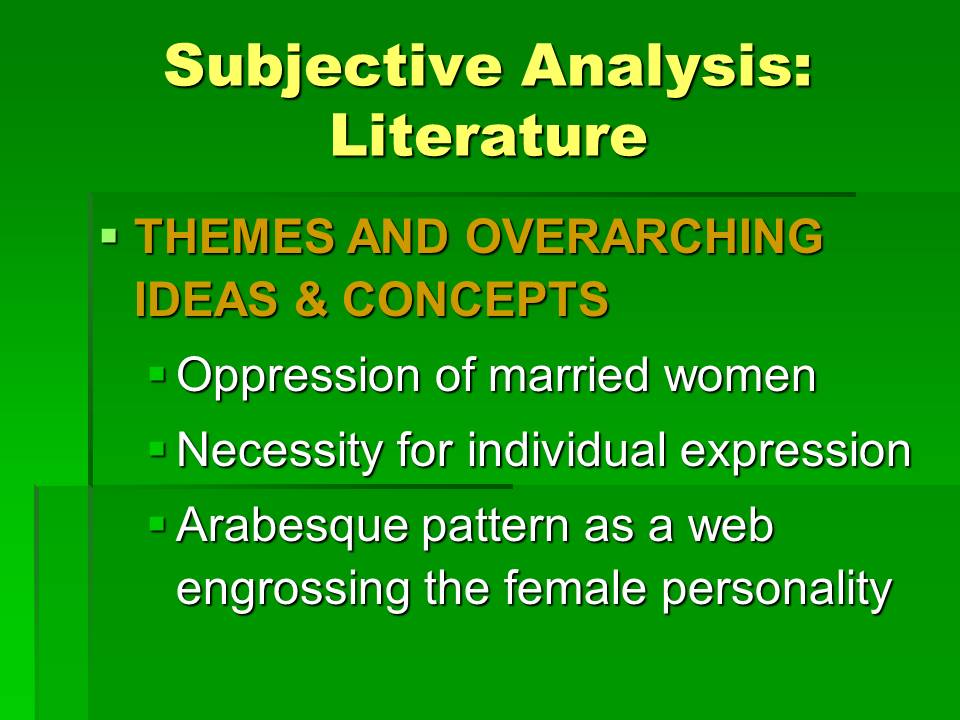
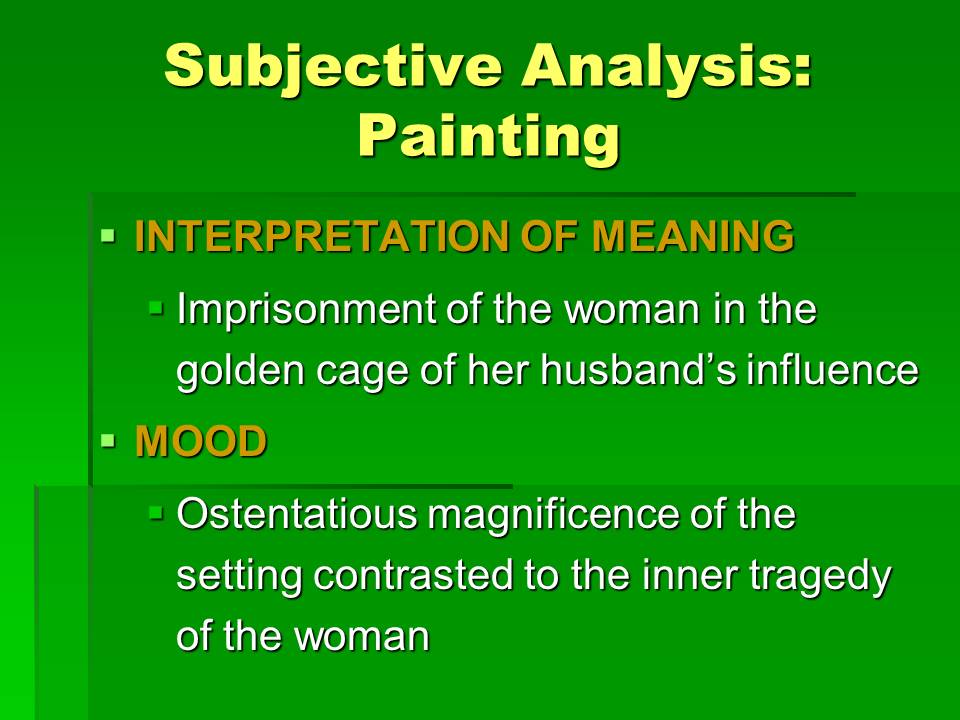
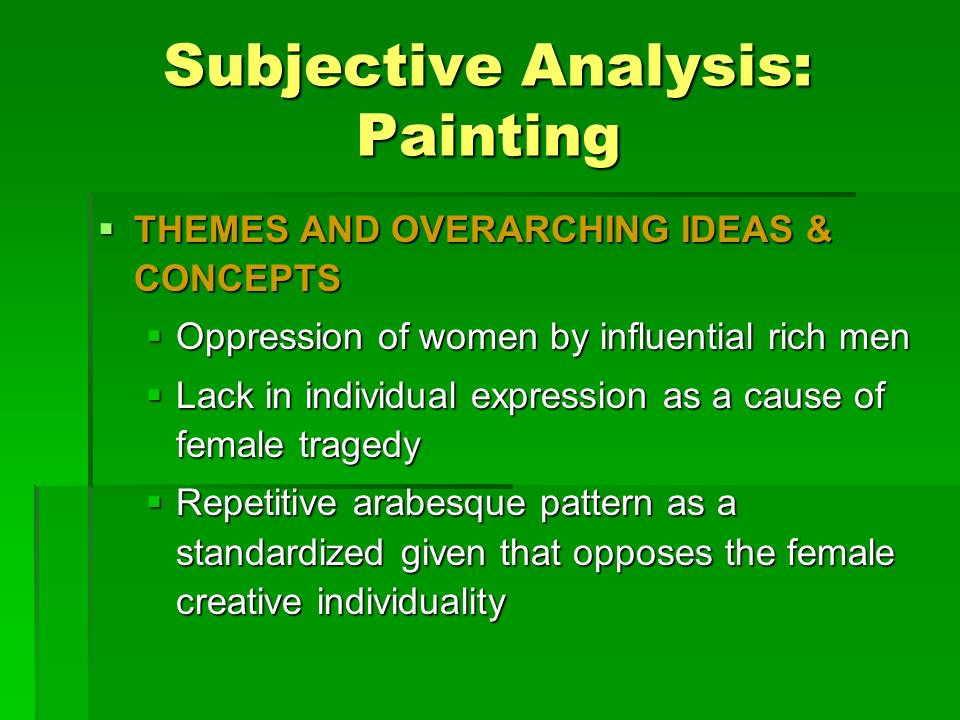
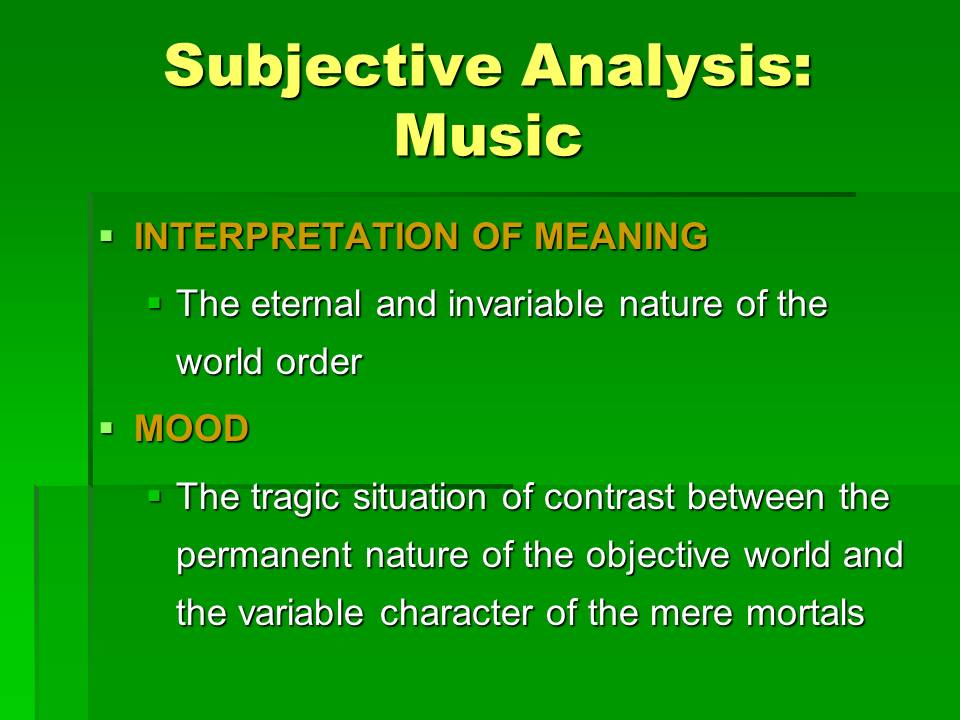
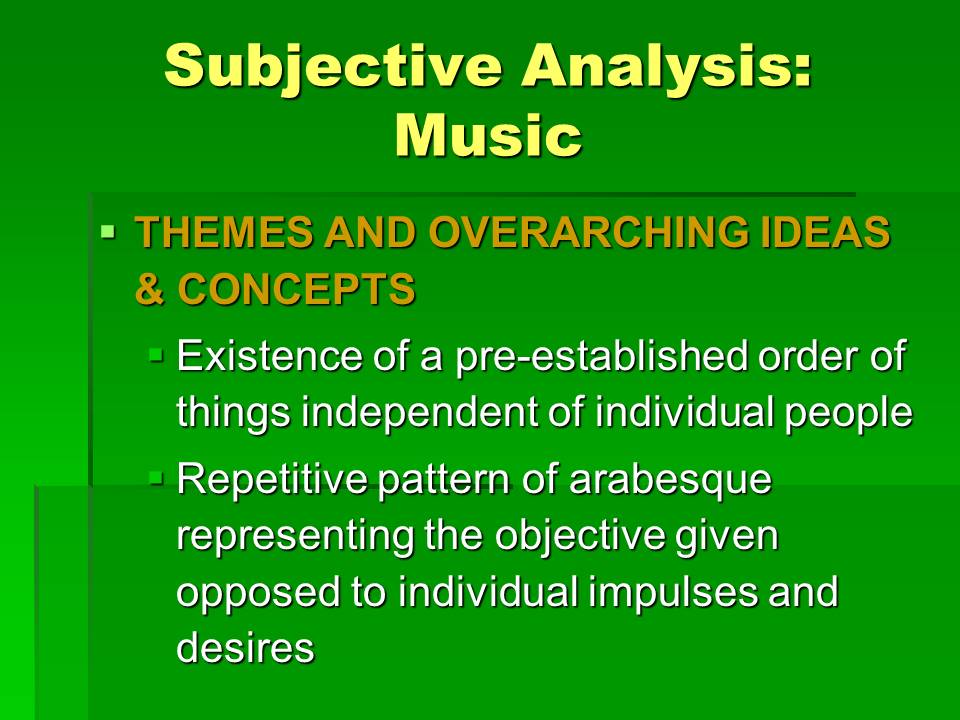
Relationship among the Works
Similarities
- Subject matter
- Common to the short story and the painting depiction of a woman in restricted circumstances
- Mood
- Common to all the three works dramatic contrast between the objective reality and the individual
In terms of subject matter, both the short story and the painting demonstrate a similar object of depiction, a woman in restricted circumstances. All the three works of art are similar by their mood of dramatic contrast between the objective reality and the individual opposed to that reality and deprived of the possibility for self-expression.
Themes & overarching concepts
- Common to all the three works:
- Existence of objective restrictive circumstances
- Arabesque as a repetitive pattern symbolizing eternity and permanency
- Common to the short story and the painting:
- Oppression of women by influential men
- Necessity of self-expression for personal happiness
The similarities among the works are traced on the level of themes and ideas as well. All the three works feature the theme of existence of objective circumstances that restrict certain aspects of human life. In this context, arabesque appears in all the works as a repetitive pattern that symbolizes eternity and permanency.
Additionally, the short story and the painting demonstrate similarity on more specific thematical levels. Thus, both of works feature oppression of women by influential men, and the necessity of self-expression for personal happiness of women.
Differences
- Subject matter
- The music pieces are more focused on the pattern of arabesque itself, while in the short story and painting arabesque functions as an auxiliary element enhancing the overall meaning
- Mood
- Less dramatic tension between the objective and the subjective in Debussy’s music
In terms of the subject matter, the difference among the three works is that while the music Arabesques are more focused on the pattern of arabesque itself, the short story and painting feature arabesque as an auxiliary element enhancing the overall meaning. As for the mood, no significant differences are observed among the works. The only remark that can be made here is that Debussy’s music does not openly unfold any dramatic conflict between the objective and the subjective, while the short story and the painting demonstrate rather tense relations between those two spheres.
Themes & overarching concepts
- Absence of female oppression theme in the music pieces.
The key difference among the three works under discussion is that, unlike the short story and the painting, the music pieces demonstrate no direct allusion to the theme of female oppression. This may be partially due to the objective and abstract character of music itself as opposed to literature and painting as more concrete arts.
Discussion
- A deeper understanding of moods and themes
- Differenciation between the concrete and the abstract arts:
- Concrete arts are able to express more specific themes
The analysis of similarities and differences among the three works under discussion has led to a deeper understanding of moods and themes. Upon comparison of the works, it has become apparent that the abstract character of music does not allow for too detailed expression, while more concrete arts of literature and painting are able to express much more specific themes.
Human Condition
- Opportunity for self-expression
- Equality of men and women in their rights
- Balance between the objective and the subjective constituents of life
- Value of individual contribution for self-sufficiency
Upon analyzing the themes, moods, and meanings in the three works of literature, painting, and music, it becomes apparent that human condition by large depends on the following factors. Firstly, any human being should have the opportunity for self-expression. Secondly, both men and women should possess equal rights as to decision on their own actions. Thirdly, both objective and subjective constituents should be present in life, and a right balance between them should be achieved without exaggerating the significance of one or the other. Last but not least, the value of individual contribution is enormous for one’s self-sufficiency: knowing that one is doing something significant to at least one person in the world constitutes individual happiness.

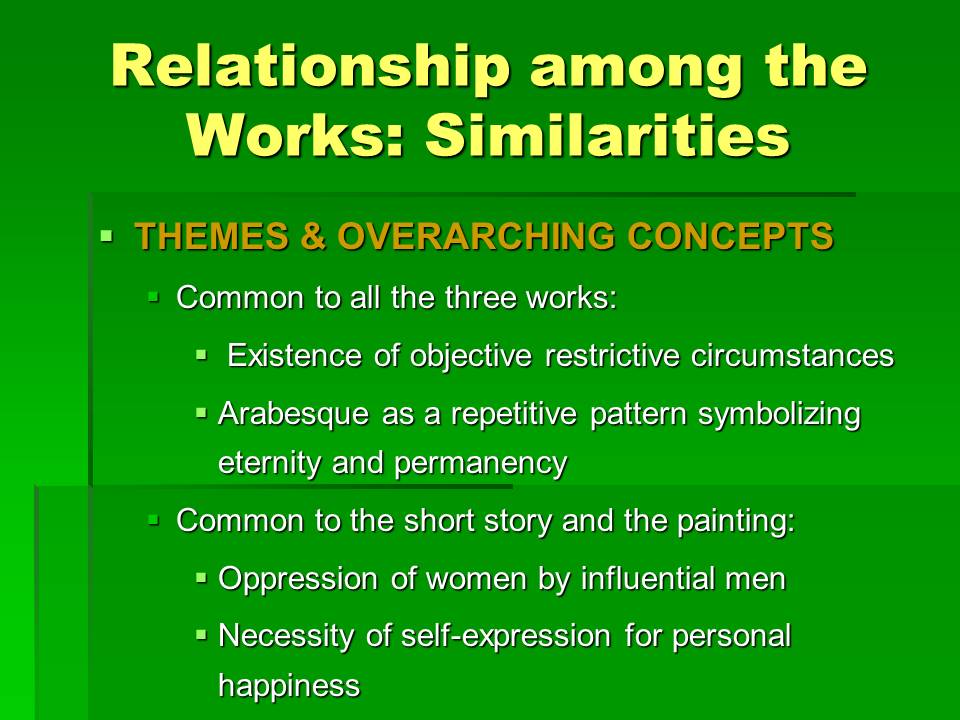
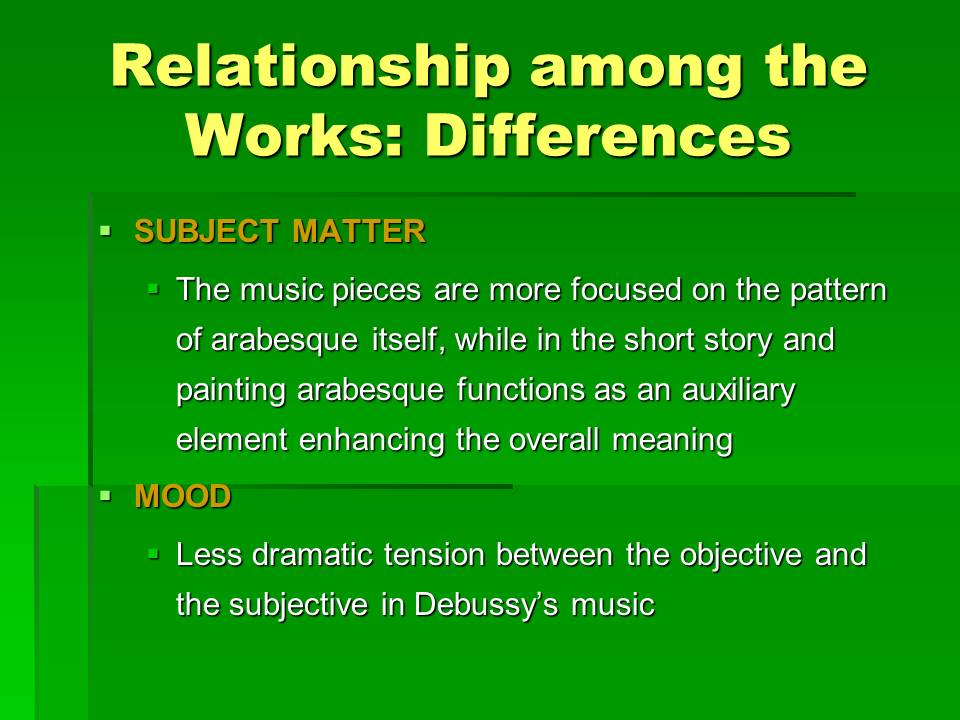
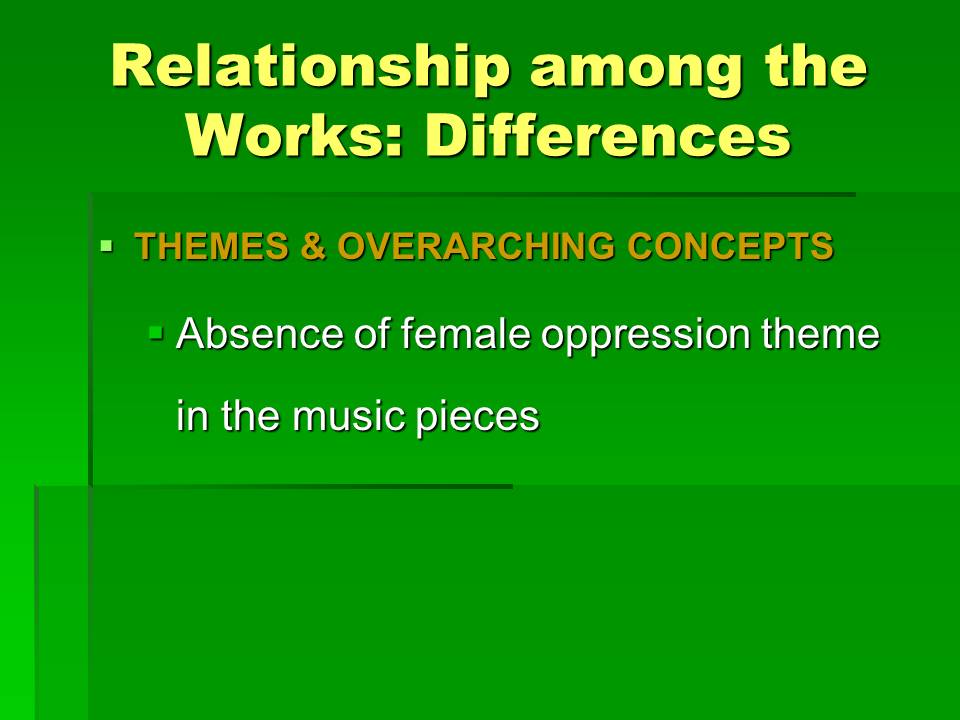
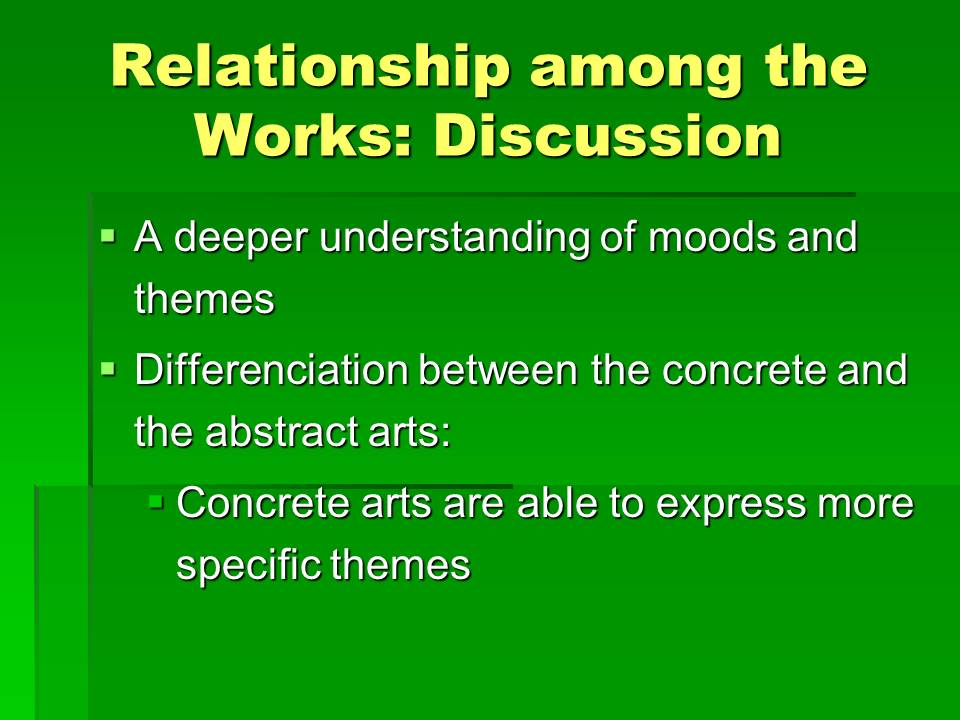
Reflection on Analysis
Human Condition
- Opportunity for self-expression
- Equality of men and women in their rights
- Balance between the objective and the subjective constituents of life
- Value of individual contribution for self-sufficiency
Upon analyzing the themes, moods, and meanings in the three works of literature, painting, and music, it becomes apparent that human condition by large depends on the following factors. Firstly, any human being should have the opportunity for self-expression. Secondly, both men and women should possess equal rights as to decision on their own actions. Thirdly, both objective and subjective constituents should be present in life, and a right balance between them should be achieved without exaggerating the significance of one or the other. Last but not least, the value of individual contribution is enormous for one’s self-sufficiency: knowing that one is doing something significant to at least one person in the world constitutes individual happiness.
Professional Relation
Arabesque pattern as relating to profession of network designer due to its:
- Objectivity
- Consistency
- Repetitiveness
Among the leading overarching concepts in all of the three works of art is the pattern of arabesque. As a network designer, I can relate to this pattern due to the qualities of objectivity, consistency, and repetitiveness inherent in arabesque. The work of network designer presupposes employing all of the aforementioned characteristics for the success of the projects, and therefore arabesque could become a symbol of network design as a messenger of eternal and objective order of things.
Knowledge of Humanities
Significance of the humanities for a network designer:
- Tracing connections between different phenomena
- Establishing general patterns of life
- Congnizing the common laws of existence
The experience of studying humanities proves invaluable to a network designer, since comparing and contrasting works of different genres and arts, one learns several skills that are crucial for IT professions. Firstly, one learns to trace connections between different phenomena. Secondly, one learns to establish general patterns of functioning. Last but not least, one cognizes the common laws of existence. All those skills of analytical thinking can be acquired when studying humanities and increasing one’s understanding of the systematic and interconnected nature of the world.
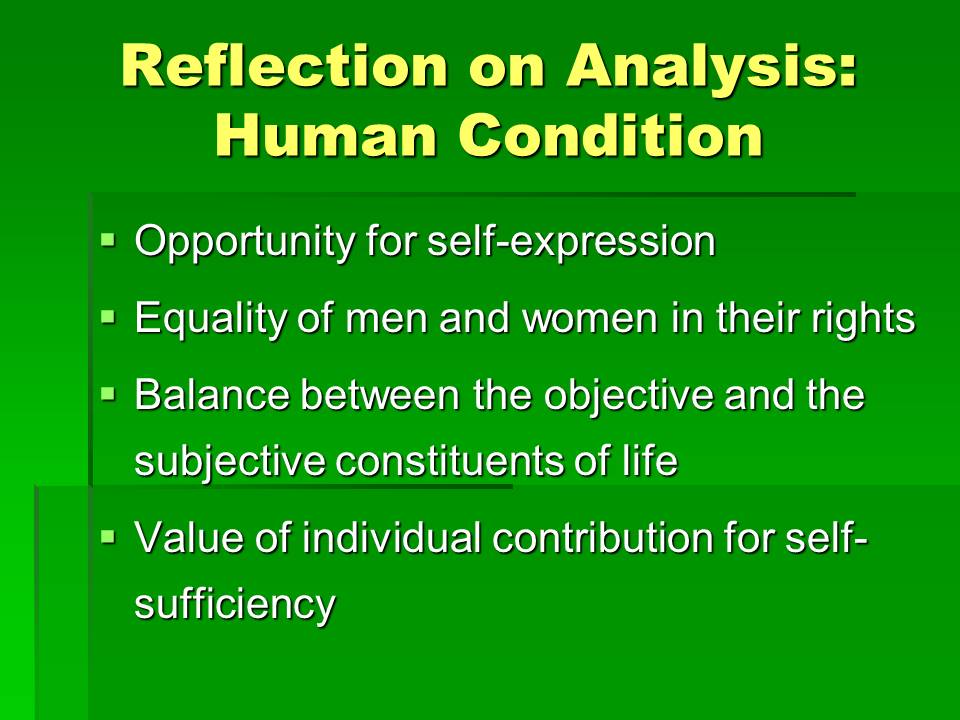

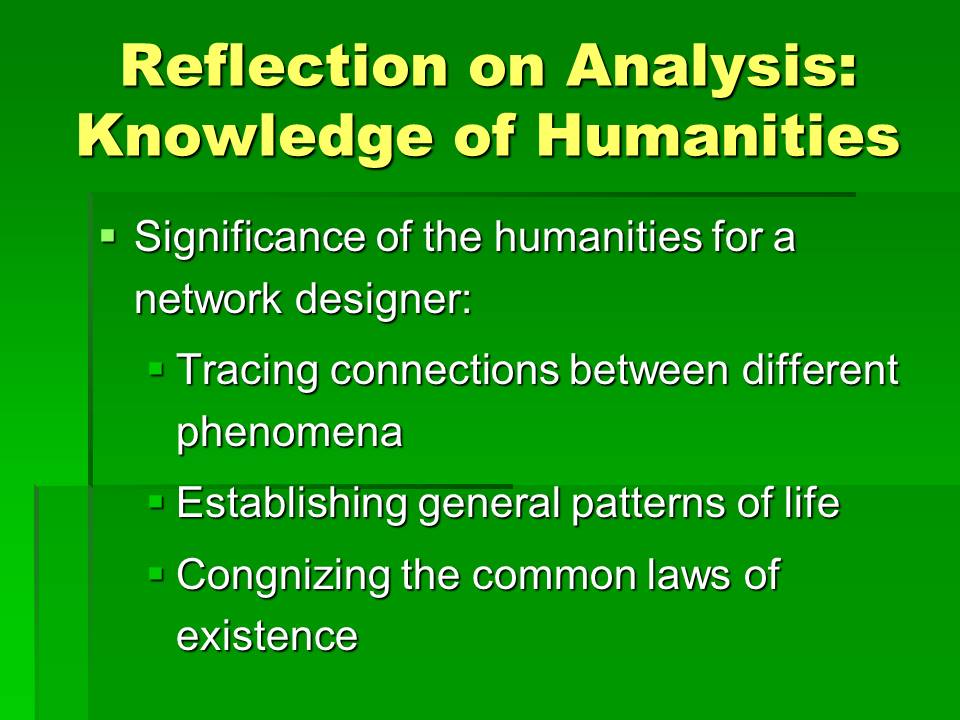
Conclusion
Main themes of the three works:
- Female oppression by men
- Necessity for self-expression
- Existence of objective order of things
- Conflict between the creative individual and the restricting objective reality
- Arabesque as expression of the eternal order of things
- Significance of arabesque symbol for IT professions due to its:
- Objectivity
- Consistency
- Repetitiveness
Having analyzed the three works of literature, painting, and music, it has become possible to single out several dominant themes that are common for all those works and that have been important for society for centuries onwards. Those themes include: female oppression by men; necessity for self-expression; existence of objective order of things; conflict between the creative individual and the restricting objective reality.
In context of all the three works, there is an element that unites them and serves as an expression of the eternal order of things. This element is the pattern of arabesque, and its importance for IT profession can be based on its following characteristics: objectivity, consistency, and repetitiveness. The aforementioned qualities characterize not only the arabesque but the peculiarities of work in IT. Therefore, arabesque can be accepted as a symbol and a guiding emblem for IT specialists.
